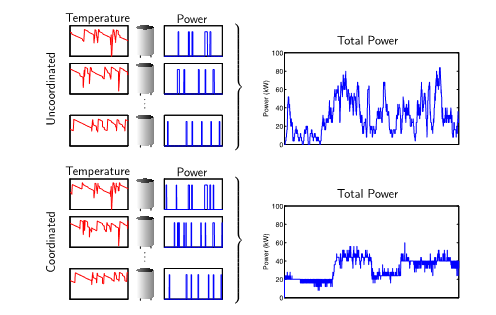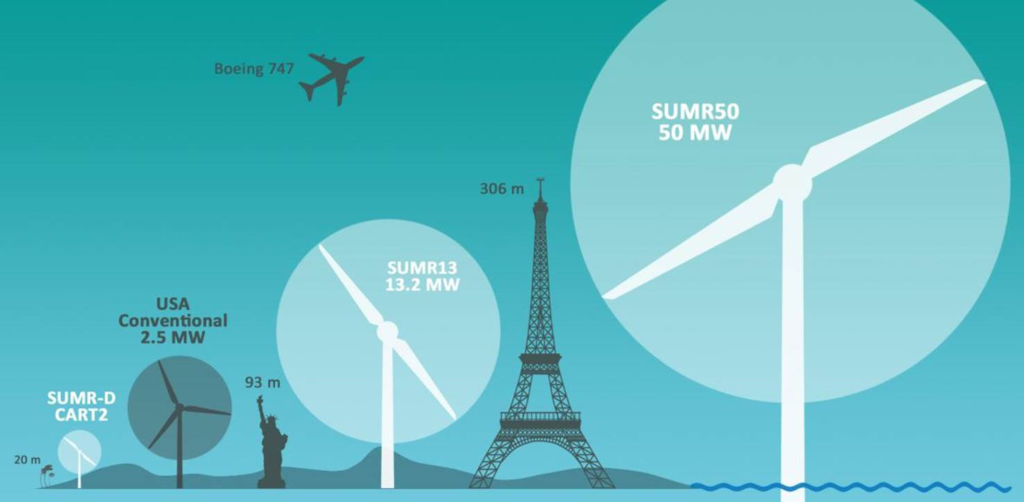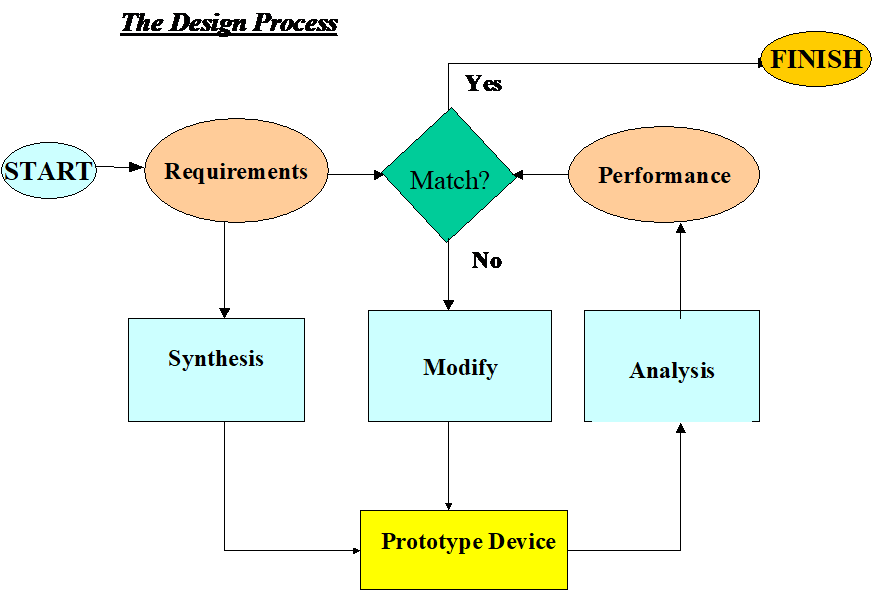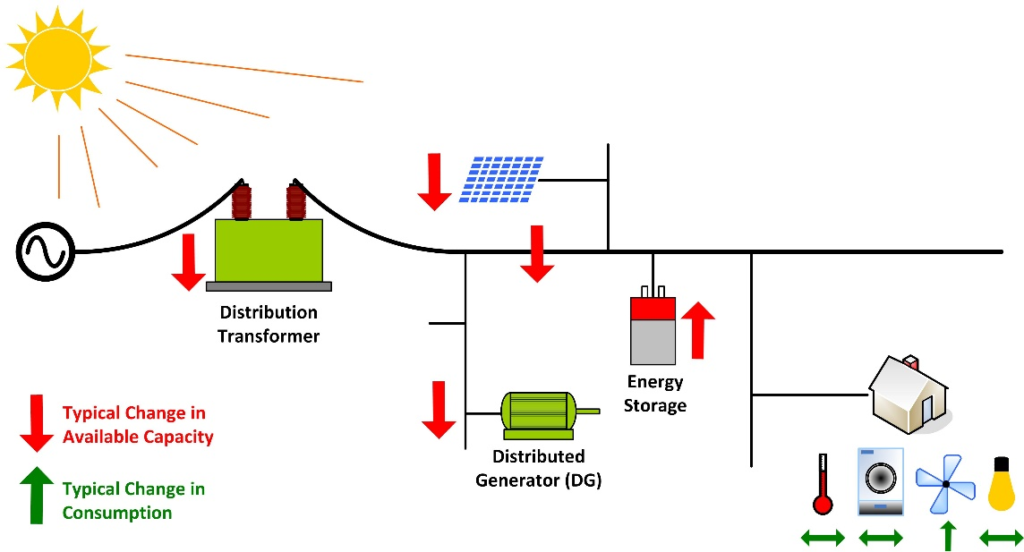Research is a fundamental aspect of electrical and computer engineering and an essential part of graduate-level study.
The department offers numerous opportunities for both undergraduate and graduate students to engage in faculty members’ research. Students are encouraged to reach out to faculty members to inquire about potential opportunities to participate in their research.
Explore our research areas:

The Electrical Engineering Department has an internationally recognized faculty (IEEE and ACES fellows) specializing in antennas and wireless communications. Their expertise spans diverse but interconnected fields, including computational electromagnetics, electromagnetic radiation and scattering, antennas and antenna arrays, microwave circuits, radar, remote sensing, electromagnetic measurements, visualization, and wireless communications.
Sample Projects
Isoflux Phased Array Design for Cubesats
 PI: Atef Z. Elsherbeni
PI: Atef Z. Elsherbeni
This project aims for the optimization and design process of an isoflux phased array for Cubesats in low Earth orbit (LEO) operating at the upper end of the X-band. At this frequency, the array becomes small enough to fit on the 1U face of a Cubesat based on a compromise between the number of elements needed to create a reasonable isoflux pattern and the aperture size of the array in wavelengths. The isoflux array allows for effective communication over a large portion of Earth’s surface. Moreover, the array does not require any mechanical parts that can fail on launch or over the lifetime of the satellite, thus increasing reliability. An optimization process based on the genetic algorithm is used to create a multi-ring concentric circular phased array that creates a near-isoflux power pattern on the Earth surface. The genetic algorithm yields appropriate element spacing, amplitude, and phase shifts. Simple microstrip patch antennas are used for the array design for proof of concept, with full wave simulation demonstrating the array performance.
Areas Of Expertise
- Computational Electromagnetics
- Antennas and Antenna Arrays
- Microwave Semiconductor Devices
- Remote Sensing and RFIDs
- THz Applications
- Superconducting Circuits
- Low-Noise and MM- Wave Applications
Recent Key Contributions
- NRT Quantum Engineering ($3M)
- ARFL Contract
- Donation from ARDC
- BIPOC Scholarships
- Partnerships with NIST

ISS is an interdisciplinary research area that encompasses the fields of control systems, signal and image processing, compressive sensing, and optimization. This group focuses on fundamental research in the development, characterization, and implementation of algorithms for processing and acting upon data sources. Their work also explores applications in energy systems, image analysis, communication systems, and robotics.
Sample Projects
Title: Multi-fidelity modelling and control for buildings
PI: Kathryn Johnson

Highly detailed modeling and control of distributed end uses, such as buildings, on a large scale are becoming increasingly important with the adoption of renewable energy and the continued grow of emerging technologies. These large-scale, detailed simulations require immense computational power, often leading to simplifications that can cause significant performance degradation. This research aims to leverage the accuracy of high-fidelity (nonlinear) models and the simplicity of low-fidelity (linear) models to achieve highly accurate simulations while minimizing computational demands. The proposed method involves continuously updating a reduced-order linear model with knowledge from its high-fidelity counterpart, using a gaussian process surrogate model, to accurately model current conditions in a building. This parameter varying linear model retains the low computational requirements of a linear model while accurately modeling a building’s dynamics. This allows a building controller to make highly informed actions without requiring a large computational budget.
Title: Sociotechnical engineering education
PI: Kathryn Johnson
Description: Engineering practice is sociotechnical, meaning that social elements inform technical elements and vice versa in ways that are impossible to truly separate. However, engineering education frequently reduces complex real-world problems into decontextualized, closed-ended ones that render the sociotechnical elements, driving forces, and impacts invisible. Our team has studied sociotechnical elements in four engineering classes at two universities to seek to understand how sociotechnical thinking develops in engineering students. One tool for helping to develop sociotechnical thinking skills is to expand the problem definition by making visible the driving forces and assumptions that may have led to the reduced articulation of the problem, which thereby artificially restricts the problem’s solution space.
Web site: https://www.mines.edu/sociotechnicaleducation/
Distributed Control of Thermal Loads for Aggregated Demand Response
PI: Tyrone Vincent
 Residential thermostatically controlled loads (TCLs) such as ACs, heat pumps, water heaters, and refrigerators, represent about 20% of the total electricity consumption in the United States, and thus offer significant potential for actively varying their behavior to help balance electricity supply and demand. TCLs have inherent thermal storage, so their electricity consumption can be modulated while still meeting the desired temperature requirements of the end user, but these variations must be coordinated in order to meet global grid balancing objectives.
Residential thermostatically controlled loads (TCLs) such as ACs, heat pumps, water heaters, and refrigerators, represent about 20% of the total electricity consumption in the United States, and thus offer significant potential for actively varying their behavior to help balance electricity supply and demand. TCLs have inherent thermal storage, so their electricity consumption can be modulated while still meeting the desired temperature requirements of the end user, but these variations must be coordinated in order to meet global grid balancing objectives.
Tracking Low-Dimensional Information in Data Streams and Dynamical Systems
PI: Michael Wakin
![]() Recent advances in sensor technology have allowed observation of massive data about complex dynamical systems at an unprecedented scale. Low-dimensional models serve as a useful structure for understanding the information in high-dimensional signals and systems. However, this information often changes over time, and so these models can further be improved by exploiting temporal dynamics. This project is concerned with developing new methods for tracking changing low-dimensional structure in data streams and dynamical systems, particularly in settings where the observations may be missing, incomplete, corrupted, or compressed. This research aims to 1) develop techniques for tracking low-dimensional structure and, in particular, to extend tracking capabilities far beyond conventional signals to much more general data sets with intrinsic low-dimensional structure; 2) develop new tools for tracking low-dimensional structure in systems jointly with estimating the content of time-varying signals and data sets; 3) perform low-dimensional quantitative and qualitative analysis in systems that are too complex and high-dimensional for system identification.
Recent advances in sensor technology have allowed observation of massive data about complex dynamical systems at an unprecedented scale. Low-dimensional models serve as a useful structure for understanding the information in high-dimensional signals and systems. However, this information often changes over time, and so these models can further be improved by exploiting temporal dynamics. This project is concerned with developing new methods for tracking changing low-dimensional structure in data streams and dynamical systems, particularly in settings where the observations may be missing, incomplete, corrupted, or compressed. This research aims to 1) develop techniques for tracking low-dimensional structure and, in particular, to extend tracking capabilities far beyond conventional signals to much more general data sets with intrinsic low-dimensional structure; 2) develop new tools for tracking low-dimensional structure in systems jointly with estimating the content of time-varying signals and data sets; 3) perform low-dimensional quantitative and qualitative analysis in systems that are too complex and high-dimensional for system identification.
50-MW Segmented Ultralight Morphing Rotor Wind Turbine
PI: Kathryn Johnson
 The 50-MW Segmented Ultralight Morphing Rotor wind turbine project is a multi-institutional, multi-disciplinary effort “to conceptualize, design and demonstrate morphing technologies for 50-megawatt wind turbines that can reduce offshore levelized cost of energy by as much as 50% by 2025” (www.sumrwind.com). The University of Virginia leads the research, with Colorado School of Mines (CSM), University of Colorado-Boulder, National Renewable Energy Laboratory (NREL), Sandia National Laboratory, University of Illinois, and University of Texas-Dallas as partners. The CSM team is responsible for control systems design and testing, working iteratively with aerodynamics, structural design/dynamics, and cost of energy experts to achieve significant improvements compared to today’s state-of-the-art wind turbines. The bio-inspired load alignment concept is facilitated by a downwind configuration and advanced control technologies.
The 50-MW Segmented Ultralight Morphing Rotor wind turbine project is a multi-institutional, multi-disciplinary effort “to conceptualize, design and demonstrate morphing technologies for 50-megawatt wind turbines that can reduce offshore levelized cost of energy by as much as 50% by 2025” (www.sumrwind.com). The University of Virginia leads the research, with Colorado School of Mines (CSM), University of Colorado-Boulder, National Renewable Energy Laboratory (NREL), Sandia National Laboratory, University of Illinois, and University of Texas-Dallas as partners. The CSM team is responsible for control systems design and testing, working iteratively with aerodynamics, structural design/dynamics, and cost of energy experts to achieve significant improvements compared to today’s state-of-the-art wind turbines. The bio-inspired load alignment concept is facilitated by a downwind configuration and advanced control technologies.
Areas of Expertise
- Control Systems
- Sensing and Signal Processing
- Wind Energy Control Systems
- Engineering Education
- Optics and Photonics
- Data Science and Machine Learning
Recent Key Contributions
- ARPE-E USFLOWT ($990K)
- ARPA-E Fuel Cell ($3M)

PES is a research area dedicated to the design, operation, and control of energy systems, ranging from large-scale electric power grids to smaller systems such as industrial or residential microgrids. Our work focuses on solutions for controlling and integrating renewable energy resources into the power grid, developing optimal algorithms to enhance energy system operations, creating models and solutions for analyzing and controlling electric machines, and findings ways to strengthen the grid’s resilience against both natural and human-caused hazards.
Sample Projects
Design Optimization of AEPS Components Using AI-EM Techniques
PI: Abd Arkadan; funded by Office of Naval Research (ONR), Long Range Scientific and Technology Program
 In this project, we developed characterization and design optimization environments utilizing artificial intelligence (AI) techniques in conjunction with Electromagnetic – State Space models for the design optimization problem of Advanced Electric Power Systems (AEPS) components. The AI environment exploits the large degree of uncertainty in system characteristics to achieve fast, accurate, robust, low cost solution based on some knowledge of the performance. This approach is investigated as the design optimization of AEPS, components necessitates the simultaneous solution of the governing electrical/magnetic and mechanical equations due to the coupled nature of the electromagnetic and mechanical forces and the tight coupling between its electrical and magnetic fields as well as the nature of the devices’ nonlinear material and complicated geometries. The developed tools formed basis for detailed studies related to thermal, stress/vibration/acoustic, and Electromagnetic Interference (EMI) issues and for the development of Virtual Test Bed detailed models for Marine based Advanced Electric Power Systems.
In this project, we developed characterization and design optimization environments utilizing artificial intelligence (AI) techniques in conjunction with Electromagnetic – State Space models for the design optimization problem of Advanced Electric Power Systems (AEPS) components. The AI environment exploits the large degree of uncertainty in system characteristics to achieve fast, accurate, robust, low cost solution based on some knowledge of the performance. This approach is investigated as the design optimization of AEPS, components necessitates the simultaneous solution of the governing electrical/magnetic and mechanical equations due to the coupled nature of the electromagnetic and mechanical forces and the tight coupling between its electrical and magnetic fields as well as the nature of the devices’ nonlinear material and complicated geometries. The developed tools formed basis for detailed studies related to thermal, stress/vibration/acoustic, and Electromagnetic Interference (EMI) issues and for the development of Virtual Test Bed detailed models for Marine based Advanced Electric Power Systems.
Asset-and-User-Aware Energy DIspatch Solution for a Power Distribution System Exposed to Extreme Temperature Events
PI: Salman Mohagheghi; funded by National Science Foundation (NSF), Energy, Power, Control and Networks Program
 Extreme temperatures can push various power grid components to their operational limits. The available capacity of most generation resources, transformers, and overhead lines get negatively affected as the temperature increases beyond certain thresholds. This is becoming more important since climate models project an increase in the duration and frequency of heat waves. Unsurprisingly, the temperature-induced reduction in available power generation and power transmission capacities coincides with higher electric demand on the system, mostly attributed to the over-utilization of air-conditioning systems. In this project, we are developing optimal solutions to minimize the operational cost of the system, while at the same time minimizing the loss of life of assets due to overloading or operating under harsh conditions. In addition, we make use of A/C-based demand response as a sustainable solution, but at the same time, we acknowledge the fact that air-conditioning units are essential in maintaining an acceptable indoor temperature for the residents during heat waves. We therefore avoid overexploiting this resource which could otherwise pose risks to the end-users’ health and well-being. Collectively, we model this problem as a multi-objective optimization problem where the different objective functions are optimized while considering their direct impact on one another.
Extreme temperatures can push various power grid components to their operational limits. The available capacity of most generation resources, transformers, and overhead lines get negatively affected as the temperature increases beyond certain thresholds. This is becoming more important since climate models project an increase in the duration and frequency of heat waves. Unsurprisingly, the temperature-induced reduction in available power generation and power transmission capacities coincides with higher electric demand on the system, mostly attributed to the over-utilization of air-conditioning systems. In this project, we are developing optimal solutions to minimize the operational cost of the system, while at the same time minimizing the loss of life of assets due to overloading or operating under harsh conditions. In addition, we make use of A/C-based demand response as a sustainable solution, but at the same time, we acknowledge the fact that air-conditioning units are essential in maintaining an acceptable indoor temperature for the residents during heat waves. We therefore avoid overexploiting this resource which could otherwise pose risks to the end-users’ health and well-being. Collectively, we model this problem as a multi-objective optimization problem where the different objective functions are optimized while considering their direct impact on one another.
Areas of Expertise
- Design, Operation and Control of Energy Systems
- Power Electronics
- Integration of Renewables
- Electric Machines
- Industrial Cybersecurity
- Energy System Modeling and Simluation
- Energy System Digitalization
- In-Space and Aerospace Electric Power and Propulsion Systems
- AI and Advanced Computing for Energy Systems
Recent Key Contributions
- Development of MS SMART Grid Program

From the Department Head
 Between our high-caliber faculty, excellent faculty-to-student ratio, cutting-edge labs and equipment and strong ties to research centers and industry, Mines' electrical engineering programs are a great choice for students who want to be leaders in the field today and in the future.
Between our high-caliber faculty, excellent faculty-to-student ratio, cutting-edge labs and equipment and strong ties to research centers and industry, Mines' electrical engineering programs are a great choice for students who want to be leaders in the field today and in the future.
Peter Aaen
Professor and Department Head
Sponsors and Collaborators
Sponsors
- National Science Foundation (NSF)
- Office of Naval Research (ONR)
- Air Force Office of Scientific Research (AFOSR)
- Department of Energy (DOE)
- Advanced Research Projects Agency – Energy (ARPA-E)
- Defense Advanced Research Projects Agency (DARPA)
- National Renewable Energy Laboratory (NREL)
- Epilog Laser
- University of California
- Rocky Mountain Scientific Laboratory
- ITN Energy Systems, Inc.
- United Launch Alliance
- ArcelorMittal
- Lockheed Martin
- Keysight Technologies
- National Institute of Standards and Technology (NIST)
- Carollo Engineers
- Envision Energy
![]() #4 Top 25 Brainiest Colleges, #1 in Colorado (Lumosity, 2019)
#4 Top 25 Brainiest Colleges, #1 in Colorado (Lumosity, 2019)
![]() 6 faculty fellows of the professional organization IEEE
6 faculty fellows of the professional organization IEEE
![]() 19:1 student-faculty ratio
19:1 student-faculty ratio
![]() #2 in combining scholarly research and classroom instruction (Wall Street Journal, 2016)
#2 in combining scholarly research and classroom instruction (Wall Street Journal, 2016)
 #1 for career return on investment (Georgetown University, 2019), #2 best college value (Money Magazine, 2018)
#1 for career return on investment (Georgetown University, 2019), #2 best college value (Money Magazine, 2018)











